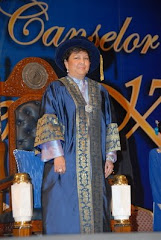 Columbia physicist Szabolcs Marka
Columbia physicist Szabolcs MarkaWhat if it turned out that you could ditch the bug spray to keep mosquitoes away –and use a beam of light instead? That’s what Szabolcs Márka, an experimental physicist, is in the early stages of researching.
Márka, 42, an associate professor at Columbia University, is an academic who lets his curiosity lead him. He had been studying optics as part of his astrophysics research (on what happens when two black holes merge) several years ago when the idea popped into his head that mosquitoes find their targets using complex sensory systems, so what about damaging or confusing those sensors? Working with colleagues including his wife associate research scientist Zsuzsa Márka (a physicist and a chemist) and Imre Bartos (an astrophysicist), he first tried knocking out and damaging the sensors of Anopheles gambiae, a malaria mosquito. Then the researchers came up with the idea of a light barrier. “We stumbled on this: If you have an invisible wall of light, how will mosquitoes and fruit flies react? They do walk or fly into it. Then they turn back. They don’t want to cross it,” says Márka. (Watch this video here to see how the mosquitoes stop at the invisible wall of light.)
He applied to the Bill & Melinda Gates Foundation and got a $100,000 grant in 2008 to pursue the research. His results were so interesting that the Gates Foundation gave him a second grant, of $1 million, to keep going. His is just one of five research groups to receive a second grant as a follow up to the foundation’s Grand Challenges Explorations grants.
The Gates Foundations’ primary interest in this research is its possible use for preventing malaria. Despite successful efforts to reduce the incidence of the disease in some countries, malaria still kills nearly 1 million people a year –mostly in sub Saharan Africa and mostly children under age 5. But the applications could be much wider. Imagine beams of light in your backyard patio keeping the bugs away — or a beam across your bedroom window, keeping the mosquitoes from entering your room.
Márka says it will be years before real practical tools emerge. Right now, his team is using the Gates Foundation grant to study the parameters of the effect they discovered. Does this apply to old mosquitoes as well as young ones? Does it work on mosquitoes that are well fed as well as those who are not? Is the best beam of light one by a window, or encircling a bed? They are also developing a mathematical model that will predict the broader effects of this tool. If you protect 50% of the people from mosquitoes, will it make the situation worse for the other 50%?
Just why the mosquitoes are repelled by the light barrier is a mystery Márka and his colleagues are still trying to unravel. “For practical purposes, it doesn’t really matter why. When I put on my scientist hat, this is the most interesting question,” says Márka. If scientists can understand how a mosquito identifies odors and gases and finds the right place to bite, Márka envisions one day creating robots with these qualities. “Imagine someone is down in a mine –we don’t want to go there. Or there’s a wounded soldier. Or there’s a person trapped close to a nuclear reactor,” he says, describing the opportunities for robots that can find humans the way mosquitoes and other arthropods do.
His insect research on the surface looks like quite a leap from previous projects in fundamental science. Márka, who is from Hungary but got his PhD at Vanderbilt University, was a nuclear physicist and spent time characterizing materials that could make nuclear reactors safer. Then he switched to particle physics and worked on building and using particle detectors destined to figure out aspects of how quarks behave. As the leader of the experimental gravity group at Columbia, he is looking into what happens when two black holes or neutron stars merge in the distant universe, is collaborating with the Laser Interferometer Gravitational Wave Observatory, a facility funded by the National Science Foundation and located in Louisiana and Hanford, Wash. that aims to detect cosmic gravitational waves Márka describes it as an instrument that “takes a light beam, splits it into two parts, brings them back together and measures whether one traveled longer than the other.” The purpose? “It’s opening a new window on the universe. You could see wonderful processes through gravitational waves—figuratively speaking, ‘the ripples of space-time itself’ –that you do not see otherwise.”
Prof. Márka’s work has earned him a spot as a finalist for the Blavatnik Award for Young Scientists, given out under the auspices of the New York Academy of Sciences and backed by Russian-American billionaire industrialist Len Blavatnik. The winner of the Blavatnik Award will be announced on Nov. 14.







